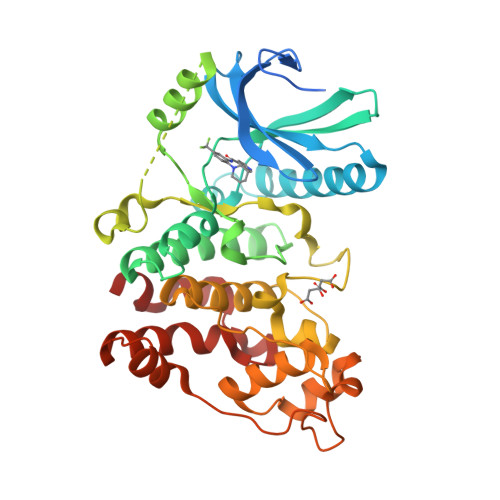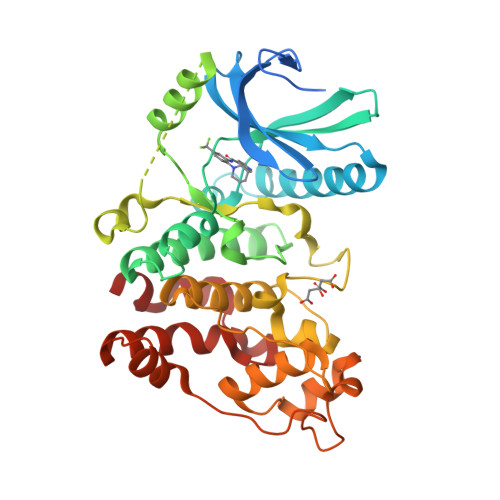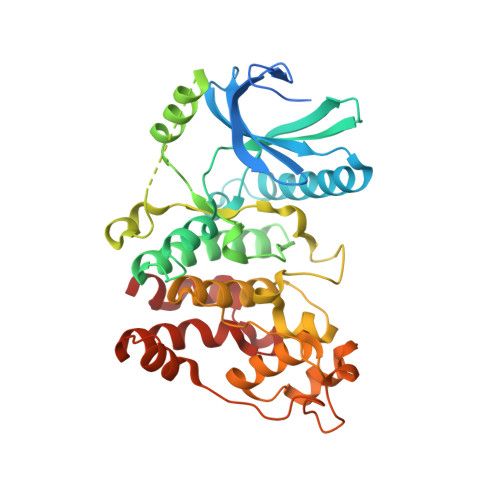Identification of a Dual Inhibitor of SRPK1 and CK2 That Attenuates Pathological Angiogenesis of Macular Degeneration in Mice
Morooka, S., Hoshina, M., Kii, I., Okabe, T., Kojima, H., Inoue, N., Okuno, Y., Denawa, M., Yoshida, S., Fukuhara, J., Ninomiya, K., Ikura, T., Furuya, T., Nagano, T., Noda, K., Ishida, S., Hosoya, T., Ito, N., Yoshimura, N., Hagiwara, M.(2015) Mol Pharmacol 88: 316-325
- PubMed: 25993998
- DOI: https://doi.org/10.1124/mol.114.097345
- Primary Citation of Related Structures:
4WUA - PubMed Abstract:
Excessive angiogenesis contributes to numerous diseases, including cancer and blinding retinopathy. Antibodies against vascular endothelial growth factor (VEGF) have been approved and are widely used in clinical treatment. Our previous studies using SRPIN340, a small molecule inhibitor of SRPK1 (serine-arginine protein kinase 1), demonstrated that SRPK1 is a potential target for the development of antiangiogenic drugs. In this study, we solved the structure of SRPK1 bound to SRPIN340 by X-ray crystallography. Using pharmacophore docking models followed by in vitro kinase assays, we screened a large-scale chemical library, and thus identified a new inhibitor of SRPK1. This inhibitor, SRPIN803, prevented VEGF production more effectively than SRPIN340 owing to the dual inhibition of SRPK1 and CK2 (casein kinase 2). In a mouse model of age-related macular degeneration, topical administration of eye ointment containing SRPIN803 significantly inhibited choroidal neovascularization, suggesting a clinical potential of SRPIN803 as a topical ointment for ocular neovascularization. Thus SRPIN803 merits further investigation as a novel inhibitor of VEGF.
Organizational Affiliation:
Department of Ophthalmology and Visual Sciences (S.M., N.Y.), Department of Anatomy and Developmental Biology (S.M., I.K., Ke.N., Ma.H.), and Medical Research Support Center (Y.O., M.D.), Graduate School of Medicine, Kyoto University, Kyoto, Japan; Laboratory of Structural Biology, Medical Research Institute (Mi.H., No.I., T.I.), and Laboratory of Chemical Bioscience, Institute of Biomaterials and Bioengineering (S.Y., T.H.), Tokyo Medical and Dental University, Tokyo, Japan; Open Innovation Center for Drug Discovery, The University of Tokyo, Tokyo, Japan (T.O., H.K., T.N.); PharmaDesign, Inc., Tokyo, Japan (Na.I., T.F.); and Department of Ophthalmology, Graduate School of Medicine, Hokkaido University, Sapporo, Japan (J.F., Ko.N., S.I.).


















